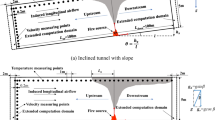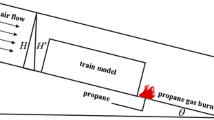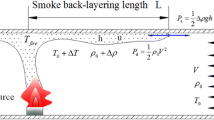Abstract
Clarifying the smoke spread and temperature distribution pattern on both sides of the fire source is the key to fire rescue. However, the back-layering length characteristics of tunnel fire smoke under multi-factor influences of tunnel slope and ventilation velocity have still not been revealed. In this paper, the smoke back-layering lengths in uplink and downlink tunnels are presented theoretically from the perspective of smoke dynamics. Meanwhile, a series of tunnel fires simulated by FDS are carried out in a reduced scale model tunnel with the dimensions of 40 m (length) × 0.93 m (width) × 0.93 m (height). Four typical slopes of 0%, 1%, 2% and 3% and five longitudinal ventilation velocities of 0.33 m/s, 0.67 m/s, 1 m/s, 1.33 m/s and 1.67 m/s are considered to investigate the influences of tunnel slope and ventilation velocity on the temperature attenuation on both sides of fire source. The theoretical analysis gives relatively good consistency with numerical results. Finally, the analytical models of non-dimensional smoke back-layering length in the inclined tunnel are obtained based on the theoretical and numerical simulation results. This work provides a reference for the smoke control and fire rescue during the tunnel fire period.












Similar content being viewed by others
References
Fan CG, Ji J, Li YZ, Ingason H, Sun JH (2017) Experimental study of sidewall effect on flame characteristics of heptane pool fires with different aspect ratios and orientations in a channel. Proc Combust Inst 36(2):3121–3129. https://doi.org/10.1016/j.proci.2016.06.196
Guo FY, Gao ZH, Wan HX, Ji J, Yu LX, Ding L (2019) Influence of ambient pressure on critical ventilation velocity and back-layering distance of thermal driven smoke in tunnels with longitudinal ventilation. Int J Therm Sci 145:105989. https://doi.org/10.1016/j.ijthermalsci.2019.105989
Zhong MH, Shi CL, He L, Shi JH, Liu C, Tian XL (2016) Smoke development in full-scale sloped long and large curved tunnel fires under natural ventilation. Appl Therm Eng 108:857–865. https://doi.org/10.1016/j.applthermaleng.2016.07.141
Tang F, Li LJ, Chen WK, Tao CF, Zhan Z (2017) Studies on ceiling maximum thermal smoke temperature and longitudinal decay in a tunnel fire with different transverse gas burner locations. Appl Therm Eng 110:1674–1681. https://doi.org/10.1016/j.applthermaleng.2016.09.054
Gong L, Jiang L, Li SY, Shen N, Zhang YC, Sun JH (2016) Theoretical and experimental study on longitudinal smoke temperature distribution in tunnel fires. Int J Therm Sci 102:319–328. https://doi.org/10.1016/j.ijthermalsci.2015.12.006
Zhao YC, Zhu GQ, Gao YJ (2018) Experimental study on smoke temperature distribution under different power conditions in utility tunnel. Case Stud Therm Eng 12:69–76. https://doi.org/10.1016/j.csite.2018.03.002
Liu C, Zhong MH, Shi CL, Zhang PH, Tian XL (2017) Temperature profile of fire induced smoke in node area of a full-scale mine shaft tunnel under natural ventilation. Appl Therm Eng 110:382–389. https://doi.org/10.1016/j.applthermaleng.2016.08.147
Yao YZ, Cheng XD, Zhang SG, Zhu K, Shi L (2016) Smoke back-layering flow length in longitudinal ventilated tunnel fires with vertical shaft in the upstream. Appl Therm Eng 107:738–746. https://doi.org/10.1016/j.applthermaleng.2016.07.027
Wan H, Gao Z, Han J, Ji J, Ye M, Zhang Y (2019) A numerical study on smoke back-layering length and inlet air velocity of fires in an inclined tunnel under natural ventilation with a vertical shaft. Int J Therm Sci 138:293–303. https://doi.org/10.1016/j.ijthermalsci.2019.01.004
Zhang X, Lin Y, Shi C, Zhang J (2021) Numerical simulation on the maximum temperature and smoke back-layering length in a tilted tunnel under natural ventilation. Tunn Undergr Space Technol 107:103661. https://doi.org/10.1016/j.tust.2020.103661
Chow WK, Gao Y, Zhao JH, Dang JF, Chow Nadia CL (2016) A study on tilted tunnel fire under natural ventilation. Fire Saf J 81:44–57. https://doi.org/10.1016/j.firesaf.2016.01.014
Weng MC, Lu XL, Liu F, Du CX (2016) Study on the critical velocity in a sloping tunnel fire under longitudinal ventilation. Appl Therm Eng 94:422–434. https://doi.org/10.1016/j.applthermaleng.2015.10.059
Merci B (2008) One-dimensional analysis of the global chimney effect in the case of fire in an inclined tunnel. Fire Saf J 43(5):376–389. https://doi.org/10.1016/j.firesaf.2007.09.003
Vermesi I, Rein G, Colella F, Valkvist M, Jomaas G (2017) Reducing the computational requirements for simulating tunnel fires by combining multiscale modelling and multiple processor calculation. Tunn Undergr Space Technol 64:146–153. https://doi.org/10.1016/j.tust.2016.12.016
Wang ZY, Ding L, Wan HX, Ji J, Gao ZH, Yu LX (2020) Numerical investigation on the effect of tunnel width and slope on ceiling gas temperature in inclined tunnels. Int J Therm Sci 152(4):106272. https://doi.org/10.1016/j.ijthermalsci.2020.106272
Zeng Z, Xiong K, Lu XL, Weng XC, Liu F (2018) Study on the smoke stratification length under longitudinal ventilation in tunnel fires. Int J Therm Sci 132:285–295. https://doi.org/10.1016/j.ijthermalsci.2018.05.038
Fan CG, Yang J (2017) Experimental study on thermal smoke back-layering length with an impinging flame under the tunnel ceiling. Exp Therm Fluid Sci 82:262–268. https://doi.org/10.1016/j.expthermflusci.2016.11.019
Zukoski EE, Kubota T, Cetegen B (1981) Entrainment in fire plumes. Fire Saf J 3:107–121. https://doi.org/10.1016/0379-7112(81)90037-0
Hu LH, Chen LF, Wu L, Li YF, Zhang JY, Meng N (2013) An experimental investigation and correlation on buoyant gas temperature below ceiling in a slopping tunnel fire. Appl Therm Eng 51:246–254. https://doi.org/10.1016/j.applthermaleng.2012.07.043
Yan GF, Wang MN, Yu L, Duan RY, Xia PX (2020) Effects of ambient pressure on smoke movement patterns in vertical shafts in tunnel fires with natural ventilation systems. Build Simul Int J 13:931–941. https://doi.org/10.1007/s12273-020-0631-4
Fan CG, Li XY, Mu Y, Guo FY, Ji J (2017) Smoke movement characteristics under stack effect in a mine laneway fire. Appl Therm Eng 110:70–79. https://doi.org/10.1016/j.applthermaleng.2016.08.120
Wei Z, Duanmu WK, Wang T, Liang TS (2016) A study of the critical velocity of smoke bifurcation flow in tunnel with longitudinal ventilation. Fire Technol 53(2):1–19. https://doi.org/10.1007/s10694-016-0605-3
Ji J, Zhu L, Ding L, Yu LX, Wan HX (2020) Numerical Investigation of external wind effect on Smoke Characteristics in a Stairwell. Fire Technol 56(4):1681–1702. https://doi.org/10.1007/s10694-020-00948-4
Zhong W, Fan CG, Ji J, Yang JP (2013) Influence of longitudinal wind on natural ventilation with vertical shaft in a road tunnel fire. Int J Heat Mass Transf 57:671–678. https://doi.org/10.1016/j.ijheatmasstransfer.2012.10.063
Tan TT, Yu LX, Ding L, Gao ZH, Ji J (2021) Numerical investigation on the effect of ambient pressure on mechanical smoke extraction efficiency in tunnel fires. Fire Saf J 120:103136. https://doi.org/10.1016/j.firesaf.2020.103136
Wang ZY, Ding L, Wan HX, Ji J, Gao ZH, Yu LX (2020) Numerical investigation on the effect of tunnel width and slope on ceiling gas temperature in inclined tunnels. Int J Therm Sci 152:106272. https://doi.org/10.1016/j.ijthermalsci.2020.106272
Oka Y, Imazeki O (2015) Temperature distribution within a ceiling jet propagating in an inclined flat-ceilinged tunnel with natural ventilation. Fire Saf J 71:20–33. https://doi.org/10.1016/j.firesaf.2014.11.002
Zhang TH, Wang GY, Hu HH, Huang YD, Zhu K, Wu K (2021) Study on temperature decay characteristics of fire smoke backflow layer in tunnels with wide-shallow cross-section. Tunn Undergr Space Technol 112:103874. https://doi.org/10.1016/j.tust.2021.103874
Evers E, Waterhouse A (1978) A complete model for analyzing smoke movement in buildings. Build Res Inform, pp 69–78
Tian X, Zhong M, Shi C, Zhang P, Liu C (2017) Full-scale tunnel fire experimental study of fire-induced smoke temperature profiles with methanol-gasoline blends. Appl Therm Eng 116:233–243. https://doi.org/10.1016/j.applthermaleng.2017.01.099
Acknowledgements
This research is supported by the National Natural Science Foundation of China (Grant No. 51974304), the Natural Science Foundation of Hebei Province (Grant No. E2020402075), the State Key Laboratory Cultivation Base for Gas Geology and Gas Control (Henan Polytechnic University) (Grant No. WS2020A05), the Qing Lan Project of Jiangsu Province, and the 2022 Graduate Innovation Program of China University of Mining and Technology.
Author information
Authors and Affiliations
Corresponding author
Ethics declarations
Conflict of interest
The authors declare that they have no known competing financial interests or personal relationships that could have appeared to influence the work reported in this paper.
Additional information
Publisher's Note
Springer Nature remains neutral with regard to jurisdictional claims in published maps and institutional affiliations.
Rights and permissions
About this article
Cite this article
Li, Q., Kang, J., Wu, Y. et al. Theoretical and Numerical Study of Smoke Back-Layering Length for an Inclined Tunnel Under Longitudinal Ventilation. Fire Technol 58, 2143–2166 (2022). https://doi.org/10.1007/s10694-022-01250-1
Received:
Accepted:
Published:
Issue Date:
DOI: https://doi.org/10.1007/s10694-022-01250-1




